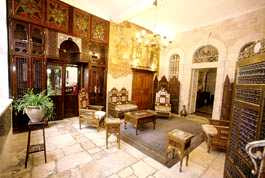
Father and Son in the River Jordan

Bishop with dove and Israeli army escort
JERICHO, West Bank, Jan 18, 2007 (AFP) - Thousands of Orthodox Christians joined in a festive pilgrimage Thursday to the Jordan River site where Jesus is believe to have been baptised.
First a handful of brave souls clambered over a security fence that had been set up to keep them back from the last few, very steep, metres (yards) leading into the river, a few kilometers east of the town of Jericho.
But sections of the fence was eventually broken down by the press of hundreds more in their enthusiasm to reach the slow-moving muddy waters.
They came from much of the Orthodox world, including Greece, Cyprus, Romania, Bulgaria and as far away as Georgia, as well as Israel and the Palestinian territories, but most of them were Russian.
Dozens of people could be seen earlier, modestly hiding behind sheets held up for them, or simply wrapped in towels, changing out of their clothes and into thin cotton tunics to prepare for a reenactment of their own baptisms.
The event was to mark the Feast of the Epiphany, the time when Jesus began his public ministry by receiving baptism at the hands of John the Baptist.
Western Christians celebrate Epiphany on January 6, which is 12 days after Christmas. The Orthodox, who continue to use the old Julian calendar, mark the date on January 18.
The celebrations, in a carnival-like atmosphere under a warm sun, began at the 5th century monastery of St John the Baptist, which sits on a hill overlooking the river several hundred metres away in what is normally a closed Israeli military zone.
The Greek Orthodox Patriarch of Jerusalem, Theophilos III, was received there by hundreds of faithful and clerics and a marching band of youths, complete with bagpipes.
As he stepped out of his car, he was greeted by another cleric who had been holding a white dove, a symbol of the Holy Spirit, which was released into the air.
After prayers in the monastery church, the dignitaries and pilgrims processed down a winding desert road between mine fields to a pavilion just above the river bank, where were more prayers were sung.
The patriarch then went down to bless the waters of the river itself.
That was the signal for hundreds of people who had been waiting nervously behind police barricades to press forward toward the river, whose steep banks were lined with scrubby trees and rushes.
Israeli soldiers and police did their best to control the crowds, but were eventually rendered useless.
Only a few metres across the narrow river was the Jordanian side, and a number of soldiers had come down to the water to watch.
The scene was a joyous one.
Theona Kakidze had traveled from Tblisi, Georgia with her priest and a group of about 25 pilgrims.
"It is very beautiful," she said. "I can't explain what I am feeling now."
Down by the river, words were unnecessary.
A Russian and his son, who appeared to be about 10 years old, had gone down into the river together. The man embraced the boy and they both disappeared under the water, before surfacing, and repeating the ritual two more times.
That was to commemorate the Orthodox batismal rite, which calls for immersion in the name of the Father, then of the Son and then the Holy Spirit.
Less brave souls had made their way down on to the trampled reeds to dip plastic bottles into the river and then pour water over themselves, blessing themselves as they did.
Two generous and enterprising young men were dipping large tin cans into the water by improvised "fishing poles" and filling the bottles of others.
Standing next to them were two Israeli civil defence workers, armed with coils of strong yellow rope in case anyone needed rescuing.
One woman, clad from head to toe in black, had immersed herself in the river and seemed unable to get out. After several attempts with the rope, two strong young men grabbed her hands and dragged her unceremoniously out of the water.
Elsewhere, people could be seen guarding shopping trollies full of litre and a half bottles that they had filled with the water to take home with them to Russia.
Back on the dais, after the final prayers had been chanted, people scrambled forward to dip their bottles into the water of a large copper baptismal font that the patriarch had blessed.
One Greek nun, who couldn't make her way up, handed her bottle to a man above her, and he dipped it into the font, bringing up not more than a few teaspoonsful.
She took the bottle back with a word of thanks in Greek, and they began to chat.
Then, in a moment iconic of the divisions that plague humanity, and Christianity, she asked the man: "Are you Orthodox or (Roman) Catholic?"
He replied that he was Anglican. She began to berate him and said "this is only for the Orthodox. The Catholics have nothing to do with the Orthodox."
But an elderly woman, with whispy white hair and kindly eyes standing next to her smiled with gratitude when the man, his hand still wet from the font, offered it to her and she pressed it against her face.
Albion Land





